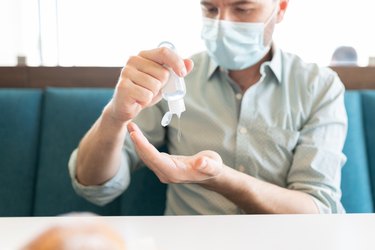
Thanks to all the common spaces, as well as the horde of hands that touch your plates, utensils and glasses, you may be wary of the germs lurking around restaurants.
In the era of the novel coronavirus pandemic, dining out is even more dicey — if you're not vaccinated, there's a risk you'll contract or spread the virus.
Video of the Day
Video of the Day
If you don't want a side of microorganisms with your main dish, read on for expert ways to avoid catching (or spreading) germs at a restaurant.
Get tips on how to stay healthy, safe and sane during the novel coronavirus pandemic.
1. Decide Whether Dining Out Is Worth the Risk
First things first, your risk level definitely depends on your vaccination status. For someone who is fully vaccinated, the Centers for Disease Control and Prevention (CDC) ranks dining indoors as a "safest" activity, but for people who are not yet vaccinated, it's considered "least safe."
Dining outside is less risky for people who aren't vaccinated, but still considered "less safe" if you share a table with people from outside your household, according to the CDC.
2. Wear a Mask
Once you're fully vaccinated, you can go to restaurants without wearing a mask, according to guidance from the CDC. That said, state or local regulations, as well as rules set by the restaurants themselves, may mean you still need to put on a face covering.
And wearing a mask is still necessary if you aren't vaccinated yet. That's what introduces risk into eating out.
"It's not possible to wear a mask while eating, which is the main reason why I would opt for takeout versus eating at a restaurant," Brandon J. Brown, MPH, PhD, an epidemiologist and associate professor in the Department of Social Medicine, Population and Public Health at the University of California, Riverside, tells LIVESTRONG.com.
COVID-19 spreads predominantly through respiratory droplets from talking, sneezing or coughing. So, there's a good chance that germs are circulating in the air when people eat their grub and gab.
That said, if you're sold on dining out, wear a mask when entering and exiting the restaurant, whenever you're not eating or drinking or when going to the restroom, Brown says.
Tip
Always use hand sanitizer (with at least 60 percent alcohol) before and after you remove your mask (and before and after you put it back on your face). Basically, slather on sanitizer any time you touch it. And handle your mask by the ear loops or ties (i.e., don’t touch the front of it) so you don’t mistakenly contaminate it.
Remember, staying masked can help mitigate your risk of being infected — or unintentionally infecting someone else — with the coronavirus. In fact, sporting a face covering is the top tactic for slashing the spread of COVID-19, per a June 2020 analysis in the Proceedings of the National Academy of Sciences (PNAS).
3. Don't Let Your Utensils Touch the Table
To avoid a mouthful of microbes, make sure your utensils never make direct contact with the table. That's because tabletops tend to be some of the germiest spots in eateries, according to University of Arizona microbiologist Charles Gerba, PhD, who cites his own research published in Food Protection Trends, which found that 70 percent of tabletops in bars and restaurants harbored harmful bacteria.
But don't servers wipe down tables after each customer? Yes, but that's part of the problem. Gerba's study discovered that almost 90 percent of dishcloths used to clean tabletops tested positive for coliforms (a type of bacteria found in poop), while 54 percent contained E. coli.
That may be in part because staff don't use proper disinfectants or, if they do, they're not allowing enough time for the disinfectant sprays to take effect, Gerba says.
OK, but what if your fork only touched the table for a few seconds? "I know that many still use the '5-second rule' to distinguish whether or not to use or consume an item after contact with a surface, but, unfortunately, microbes tend not to obey these rules," says Jason Kindrachuk, PhD, a virologist at the University of Manitoba in Canada.
Rather than risk infection, it's better to be safe and ask your server for a new set of utensils.
4. Clean Your Hands Frequently

To protect yourself and others during the pandemic, the CDC recommends that you scrub your hands with soap and water for at least 20 seconds (about the time it takes you to sing the "Happy Birthday" song twice) upon entering and exiting an eatery.
But keep in mind, public restrooms present a problem for the possible transmission of the coronavirus. Multiple stalls increase your odds of encountering more patrons who might be positive for COVID-19. If possible, stick to single-stall bathrooms to avoid contact with others.
Either way, wear your mask, use paper towels to prevent touching door handles and faucets and, if you need to use the facilities, put the toilet lid down before you flush. While more research is required, it's possible that COVID-19 is active in feces, according to a May 2020 paper in the International Journal of Infectious Diseases. This means that you can potentially aerosolize the virus when you flush.
That said, rather than making several trips to the restroom to lather up and risking exposure, it might be wiser to rely on hand sanitizer instead.
Bathrooms aren't the only hot spot for bothersome bugs in a restaurant. Throughout the course of a day, menus pass through scores of fingers. And every pair of hands leaves behind some trace of germs that could make you sick.
In fact, a July 2015 study in the Journal of Food Safety discovered the presence of staph and E. coli on restaurant menus — which were then transferred to customers' hands — and that these bacteria survived for at least two days. That's why, to reduce the potential spread of germs like the virus that causes COVID-19, the CDC recommends that restaurants get rid of reusable menus in favor of those that are disposable or digital.
But what if that's not an option and you're stuck with the same old shared menu? "Your best defense is washing your hands before and after a meal," Kindrachuk says.
But, again, disinfecting with hand sanitizer sounds like a safer bet when you consider all the potential pitfalls posed by using a shared restaurant restroom.
To ensure its effectiveness, rub the hand sanitizer over all the surfaces of your hands (the back of your mitts, too) until they're dry, the CDC says.
Related Reading
5. Cool It on the Condiments
Condiments like salt and ketchup don't add much to the nutrition value of your meal, and grabbing the shaker or bottle may not be the best idea either.
Case in point: A September 2017 study in the Journal of the Academy of Nutrition and Dietetics found coliforms and aerobic bacteria — types of common fecal bacteria that contribute to foodborne illness — lurking on the surface of salt shakers and ketchup bottles at restaurants.
If you can't live without your condiments, consider tossing a few individual packets in your bag to use instead. Or at least sanitize your hands after you touch them (just make sure you're using a quarter-size dollop of a sanitizer that's at least 60 percent alcohol).
6. Wipe Down Highchairs
Ever thought about all the dirty little fingers and poopy diapers that have occupied a restaurant highchair? Unfortunately, kids' highchairs are often cesspools swarming with nasty germs, Gerba says.
Come prepared with disinfectant wipes (make sure they're at least 70 percent alcohol, per the CDC). Before you sit your little one's butt in a booster seat, wipe down all the surfaces of the highchair, paying special attention to the attached tray where fingers and food may touch.
Read more stories to help you navigate the novel coronavirus pandemic:
- Food Protection Trends: “Identity and Numbers of Bacteria Present on Tabletops and in Dishcloths Used to Wipe Down Tabletops in Public Restaurants and Bars.”
- Journal of Food Safety: “Recovery, Survival and Transfer of Bacteria on Restaurant Menu.”
- Centers for Disease Control and Prevention: “When and How to Wash Your Hands.”
- Journal of the Academy of Nutrition and Dietetics: “Bacterial Presence on Common Objects at Bar-and-Grille Restaurants.”
- Centers for Disease Control and Prevention: "COVID-19: Resources for Households"
- Centers for Disease Control and Prevention: “Personal and Social Activities.”
- Centers for Disease Control and Prevention: “Considerations for Restaurants and Bars.”
- PNAS: “The airborne lifetime of small speech droplets and their potential importance in SARS-CoV-2 transmission.”
- PNAS: “Identifying airborne transmission as the dominant route for the spread of COVID-19.”
- International Journal of Infectious Diseases: “Potential Fecal Transmission of SARS-CoV-2: Current Evidence and Implications for Public Health.”
- Centers for Disease Control and Prevention: “Show Me the Science – When & How to Use Hand Sanitizer in Community Settings.”
- Centers for Disease Control and Prevention: "Choosing Safer Activities"
- CDC: "When You’ve Been Fully Vaccinated"
Is this an emergency? If you are experiencing serious medical symptoms, please see the National Library of Medicine’s list of signs you need emergency medical attention or call 911.